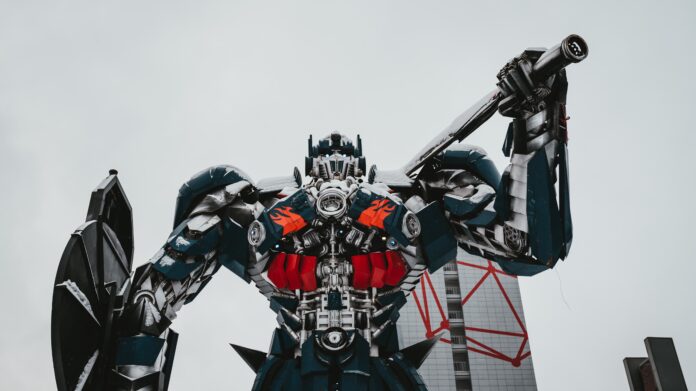Transformers are a popular and iconic franchise that has captured the imaginations of millions of fans worldwide. The concept of Transformers revolves around a group of sentient robots who have the ability to transform into various forms, such as vehicles, animals, or even everyday objects. The name “Transformers” itself refers to the ability of these robots to change their physical appearance and alter their functionality according to their needs.
The history of Transformers dates back to the early 1980s when the toy company Hasbro teamed up with the Japanese company Takara to create a line of transforming robot toys. These toys quickly gained immense popularity and paved the way for an animated television series, comic books, video games, and a blockbuster film franchise.
At the core of the Transformers universe are two warring factions: the heroic Autobots and the villainous Decepticons. The Autobots, led by their wise and courageous leader Optimus Prime, fight for peace, justice, and the protection of all sentient beings. On the other hand, the Decepticons, led by the ruthless Megatron, seek to conquer and dominate the universe.
The conflict between the Autobots and Decepticons serves as the central narrative arc for most Transformers media. The battles between these two factions often take place on Earth, with the planet serving as a battleground for their ongoing war. This setting allows for the inclusion of human characters who become intertwined with the Transformers’ struggle, adding a relatable element to the story.
One of the defining characteristics of the Transformers franchise is the concept of transformation itself. Each Transformer possesses the ability to shift between two or more forms, typically a humanoid robot mode and an alternate mode. The alternate modes can range from cars, trucks, and jets to animals, dinosaurs, and even mythical creatures. This ability to transform adds a dynamic element to the storytelling and serves as a unique selling point for the toys.
The Transformers toys are designed with intricate engineering that enables the seamless transformation between modes. The process involves a series of interlocking parts, hinges, and mechanisms that allow the robot mode to fold and reshape into the alternate mode and vice versa. This intricate engineering showcases the ingenuity and craftsmanship involved in creating these toys.
In addition to their physical transformations, Transformers also possess advanced technology and weaponry. They often wield powerful energy weapons, such as blasters and swords, which further enhance their combat abilities. Moreover, some Transformers have additional abilities, such as flight, super strength, or the power to manipulate elements like fire or electricity. These unique attributes contribute to the diverse range of characters within the franchise.
The Transformers franchise has expanded beyond the toy line and animated series, making a significant impact in the realm of live-action films. The first live-action Transformers film was released in 2007, directed by Michael Bay. The film brought the beloved characters to life on the big screen, combining cutting-edge visual effects with explosive action sequences. The success of the first film led to a series of sequels, further cementing the Transformers’ status as a global entertainment phenomenon.
While the live-action films have been criticized for their emphasis on explosive action and visual spectacle over intricate storytelling, they have undeniably introduced the franchise to a wider audience. The films have showcased the iconic Transformers characters, such as Optimus Prime, Bumblebee, and Megatron, in epic battles and breathtaking CGI sequences. Moreover, the films have expanded the Transformers lore by introducing new characters, locations, and storylines.
Beyond the films, Transformers continue to thrive in various forms of media. Animated television series, such as “Transformers: Prime” and “Transformers: Robots in Disguise,” have captivated younger audiences with their compelling narratives and vibrant animation. Comic books and graphic novels have explored deeper storylines and character arcs, delving into the rich history and mythology of the Transformers universe.
Furthermore, the popularity of Transformers has extended into the realm of video games. Numerous titles have been released across different platforms, allowing players to control their favorite Autobots or Decepticons in intense battles or engaging open-world environments. These games often provide an immersive experience, enabling players to experience firsthand the thrill of transforming between modes and unleashing devastating attacks.
The impact of Transformers goes beyond entertainment and popular culture. The franchise has left a lasting impression on the toy industry, shaping the way toys are designed and marketed. The concept of transformation has influenced subsequent toy lines, inspiring a range of products that can change shape or function in various ways. Transformers have become synonymous with the idea of toys that offer more than meets the eye, sparking creativity and imaginative play.
The success and longevity of the Transformers franchise can be attributed to several key factors. One of them is the enduring appeal of the characters themselves. Optimus Prime, with his noble leadership and unwavering sense of justice, has become an iconic figure of heroism. Bumblebee, known for his loyalty and bravery, has won the hearts of fans with his endearing personality. Megatron, on the other hand, stands as a formidable villain with his relentless pursuit of power. These and many other characters have become cultural touchstones, resonating with audiences of all ages.
Another factor that contributes to the franchise’s success is its ability to evolve and adapt over time. Transformers have undergone numerous iterations and reboots, allowing for fresh storytelling and the introduction of new characters and concepts. Each iteration builds upon the foundation laid by its predecessors while exploring new narratives and expanding the Transformers universe. This adaptability ensures that the franchise remains relevant and engaging for both longtime fans and new audiences.
The concept of transformation, central to the Transformers, also holds a metaphorical significance. The ability of the robots to change their forms reflects the human experience of self-discovery, adaptation, and personal growth. The Transformers’ journey to understand their place in the universe and the choices they make parallel our own quest for identity and purpose. This underlying theme adds depth and resonance to the stories, resonating with viewers on a deeper level.
Furthermore, the Transformers franchise has embraced diversity and inclusivity in its storytelling. Characters from different backgrounds, races, and even species (such as Dinobots and Maximals) have been introduced, fostering a sense of representation and allowing fans from all walks of life to find relatable heroes within the franchise. This commitment to inclusivity has helped the franchise remain relevant and connected to its diverse fan base.
In recent years, the Transformers franchise has also ventured into new territories, exploring collaborations with other popular franchises. Crossovers with other iconic properties, such as Marvel’s Avengers, Star Wars, and Ghostbusters, have brought together beloved characters from different universes, creating excitement and expanding the narrative possibilities. These collaborations offer fans the opportunity to see their favorite Transformers interact with other beloved characters, leading to unique and unexpected storytelling opportunities.
Beyond the entertainment value, Transformers have left a lasting impact on popular culture and society. The franchise has inspired fan communities, conventions, and cosplay events, where enthusiasts gather to celebrate their love for the Transformers universe. The enduring popularity of the franchise has also led to the creation of merchandise, ranging from clothing and accessories to collectible toys and memorabilia, further solidifying the Transformers’ status as a cultural phenomenon.
In conclusion, the Transformers franchise has left an indelible mark on popular culture and the entertainment industry. With its iconic characters, the concept of transformation, and its ability to adapt and evolve, the franchise continues to captivate audiences across generations. Through toys, animated series, films, comics, and video games, the Transformers have become a symbol of imagination, heroism, and the power of change. The franchise’s impact reaches beyond entertainment, inspiring creativity, fostering inclusivity, and forging connections among fans worldwide. Transformers truly embody the spirit of transformation and remain an enduring symbol of storytelling and adventure.














